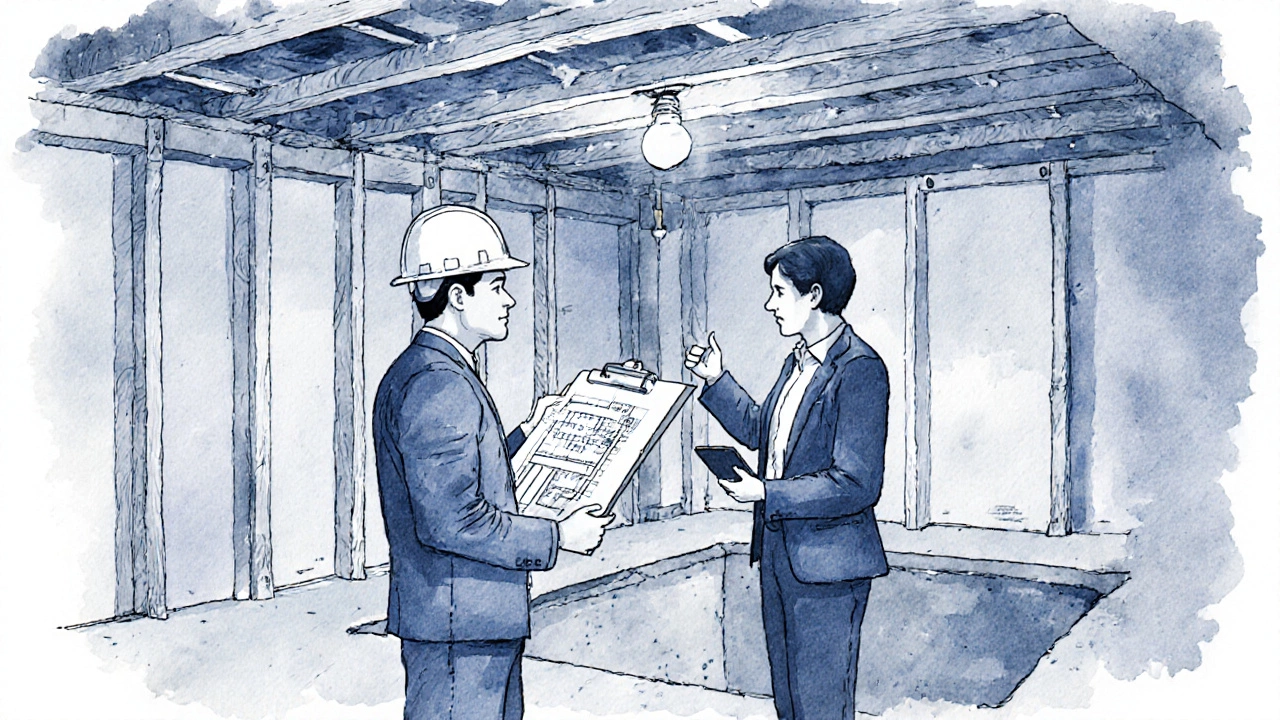Sagging Floor Insurance: What’s Covered and How to Claim
 Oct, 14 2025
Oct, 14 2025
Key Takeaways
- Standard homeowner's insurance usually excludes gradual structural issues like sagging floors unless caused by a sudden covered event.
- Document the damage, its cause, and any recent incidents before filing a claim.
- Read your policy’s "exclusions" and "perils" sections line‑by‑line; look for terms such as "gradual wear" or "soil movement".
- Working with a qualified structural engineer can turn a denied claim into an approved one.
- If insurance won’t pay, consider foundation repair financing options or a home warranty add‑on.
Understanding the Core Players
When a sagging floor is a condition where the floor surface visibly dips or feels soft underfoot, often indicating underlying structural issues shows up, homeowners instantly wonder if their homeowner's insurance the policy that protects a residence against loss or damage will foot the bill.
Two other entities shape the outcome: the insurance policy a contract that outlines covered perils, limits, and exclusions for a property, and the claim adjuster the professional who investigates loss, assesses damage, and recommends payment. Both read the same fine print but interpret it through different lenses.
What Triggers Coverage?
Insurance for homes is built around two concepts: "perils" (events that cause loss) and "exclusions" (events that are not covered). A sagging floor can be covered if the cause aligns with a named peril, such as:
- Sudden impact from a vehicle accident.
- Water damage from a burst pipe that floods the floor.
- Fire‑related structural collapse.
- Wind‑driven debris that strikes the foundation.
These are all "sudden and accidental" events, the language most insurers love. In contrast, policy exclusions specific conditions expressly omitted from coverage, such as gradual wear, soil movement, or poor maintenance block claims that stem from slow‑acting problems.
Typical Exclusions That Kill a Sagging‑Floor Claim
Even if you notice a dip after a heavy rain, the insurer may argue the damage is "gradual" or "maintenance‑related." Common exclusion clauses include:
- Gradual wear and tear: The policy states that normal aging or settlement over time is not covered.
- Soil movement or shrink‑sand: Shifts in the earth beneath the foundation caused by drought, over‑watering, or poor soil compaction are excluded.
- Pests and vegetation: Damage driven by termites, tree roots, or invasive plants is not a covered peril.
- Improper construction: If the original build didn’t meet local building codes, the insurer can deny the claim.
Reading the exact phrasing helps you decide whether to fight the denial or seek alternatives.

Step‑by‑Step: How to Test Your Coverage
- Gather your policy documents. Locate the declarations page, the "perils" list, and the "exclusions" section. Highlight any language that mentions "sudden" or "accidental" loss.
- Identify the cause. Ask yourself: Was there a recent storm, pipe burst, or accident? If the answer is "yes," you have a stronger claim.
- Document the damage. Take high‑resolution photos from multiple angles, note the date and time, and record any sounds or smells that might hint at water intrusion.
- Hire a qualified structural engineer. Their report will establish whether the sag is due to a covered event or a chronic issue like soil settlement.
- File the claim promptly. Most policies require you to report damage within 30 days of discovery.
- Prepare for the adjuster visit. Provide the engineer’s report, your photos, and any receipts for temporary repairs (e.g., tarps, dehumidifiers).
- Negotiate the settlement. If the adjuster cites an exclusion, reference the specific clause and ask for a written explanation. You can also ask for a re‑inspection.
Following this checklist maximizes the chance that your sagging floor falls under the policy’s "sudden event" umbrella.
When Insurance Says “No”: Alternative Paths
If the claim is denied, you still have options:
- Foundation repair financing. Many contractors partner with lenders to offer low‑interest loans or payment plans.
- Home warranty add‑ons. Some warranty providers cover structural repairs for a yearly fee, but read the fine print-they often exclude soil movement.
- Municipal assistance. In Wellington, the local council offers grants for homes affected by subsidence caused by seismic activity.
- Do‑it‑yourself stabilization. For minor sagging, you can install steel push piers under a licensed professional’s supervision.
Each route has its own cost structure, so compare the total out‑of‑pocket expense against the potential insurance payout.
Comparison: Coverage vs. Exclusions
| Scenario | Covered? | Typical Reason for Exclusion |
|---|---|---|
| Floor dips after a burst pipe floods the basement | Yes | N/A - water damage is a named peril |
| Gradual sag over three years due to dry soil | No | Gradual wear & soil movement excluded |
| Impact damage from a car accident in the driveway | Yes | N/A - sudden accidental impact covered |
| Termite damage weakening joists | No | Pests excluded from standard policy |
| Foundation settlement after a nearby earthquake | Usually No | Earthquake separate endorsement required |

Common Pitfalls and How to Avoid Them
Even seasoned homeowners trip up when dealing with sagging‑floor claims. Here are the most frequent mistakes and quick fixes:
- Waiting too long. Delays can trigger denial for “failure to mitigate.” Start the documentation process as soon as you notice the dip.
- Skipping the engineer. A vague description (“floor looks uneven”) rarely convinces an adjuster. A professional report adds credibility.
- Accepting the first settlement offer. Adjusters often start low. Use the engineer’s cost estimate as a bargaining chip.
- Over‑looking policy endorsements. If you own a separate earthquake or flood endorsement, it may cover otherwise excluded damage.
- Mixing repairs before claim approval. Doing major work before the insurer signs off can be seen as “self‑inflicted loss,” jeopardizing payment.
Quick FAQ
Frequently Asked Questions
Does a typical homeowner's insurance policy cover a sagging floor?
Only if the sag is tied to a sudden, accidental event listed as a covered peril-like water from a burst pipe or impact from a vehicle. Gradual settlement or soil movement is usually excluded.
What’s the best way to prove the damage is covered?
Hire a licensed structural engineer to assess the cause, collect dated photos, keep receipts for any temporary mitigation, and match the findings to a specific covered peril in your policy.
Will filing a claim raise my insurance premiums?
A single claim for structural damage can increase rates, especially if the insurer views the issue as a recurring risk. Some policies offer a “claims‑free discount” that you’ll lose after filing.
Are there any insurance endorsements that specifically cover sagging floors?
Yes. A “foundation endorsement” or “earthquake endorsement” can add coverage for soil movement, subsidence, or seismic settlement-issues typically excluded in standard policies.
What should I do if my claim is denied?
Request a written denial explanation, review the excluded language, and consider an independent appraisal. You can appeal the decision, or explore financing options for foundation repair outside of insurance.
Wrap‑Up: Your Next Move
If you’ve spotted a sagging floor, the first thing to do is read your policy with a magnifying glass and pinpoint the cause. A clear, sudden event gives you a solid footing for a claim; a slow‑acting problem usually pushes you toward repair financing. Leverage a structural engineer’s report, follow the step‑by‑step checklist, and don’t rush into permanent fixes before the adjuster signs off.
By treating the insurance process like a negotiation rather than a courtroom drama, you’ll either secure a payout or know exactly where to invest your money for a lasting fix.
